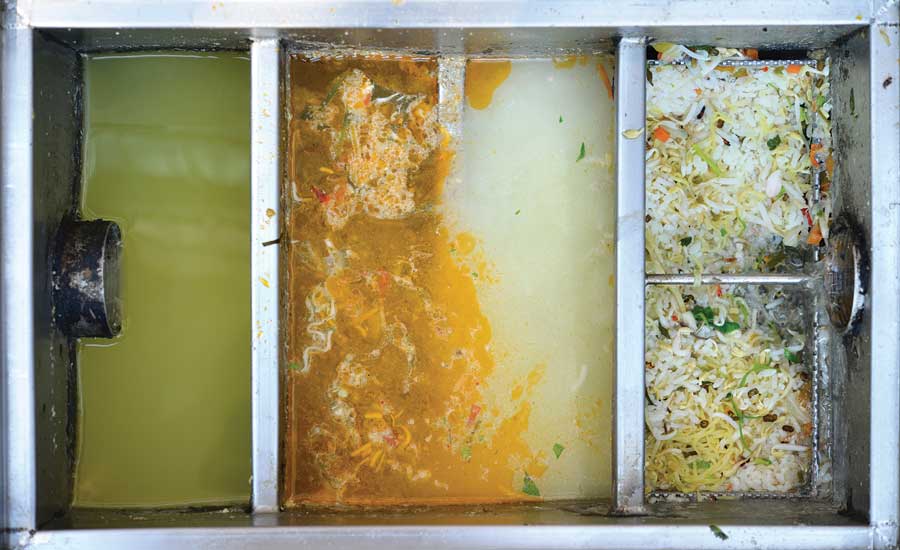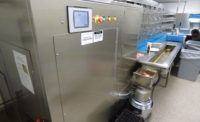Sometimes you touch a nerve and do not even realize it.
This is what occurred when I wrote in my June column, “Of course, every plumbing engineer knows the worst thing you could ever do is discharge food waste from a disposer through a grease interceptor.”
Thank you for the cards, letters, emails, phone calls and conversation regarding this subject matter. What you think is simple, sometimes becomes very complex. Perhaps it is best to go back to the beginning of plumbing codes in this country. As my colleague and fellow columnist Dan Holohan likes to say, “The Dead Men knew what they were talking about.”
The original plumbing codes emphatically stated food waste disposers shall not discharge down a grease interceptor. That was in the original ASA A40.8, BOCA Basic Plumbing Code, IAPMO Uniform Plumbing Code, PHCC National Standard Plumbing Code and SBCCI Standard Plumbing Code.
Small town causes a stir
So what happened? In the early 1980s a restaurant in a small town in Wisconsin was cited for violating the FOG (fats, oils and grease) discharge requirements. The investigation determined the grease interceptor was in fine working order and was regularly cleaned. Yet, the restaurant continued to be cited for violations from scoop tests. The waste water content exceeded 100 mg/l of FOG. More on that number later.
A plumbing designer decided to stay in the restaurant during the evening meal service. This is when he noticed employees were dumping all the grease down the food-waste disposer. Ah ha, an enlightening moment! The first thing you should recognize is that it’s not legal. Well, that plumbing designer happened to be on the Wisconsin State Plumbing Board. He requested the grease interceptor be allowed to discharge to a much larger grease interceptor that he would have installed in the parking lot. Prior to that, Wisconsin, like every other plumbing code, prohibited food-waste disposers from discharging through a grease interceptor.
As it turned out, the chief plumbing inspector for Wisconsin happens to be the chairman of the BOCA Plumbing Code Committee. He brought this information to the Code Committee and suggested a change that allows food-waste disposers to discharge through a grease interceptor. Notice it was not a requirement, only an allowance. With the chair’s political power, this easily was approved by the BOCA membership.
It didn’t stop there. During this same period of time, the three model code groups were meeting somewhat secretly to develop a combined code. However, those efforts failed and each organization brought back the information they learned and changed its individual plumbing code. The chair of the BOCA Committee served on this combined code committee. So he spread the word regarding the allowance of food-waste disposers to discharge through grease interceptors. With his influence, this happened in every other model plumbing code. Again, it was a case of allowing the practice, but never requiring.
The problems started to mount. The food particles in the grease interceptor played havoc with the performance of the grease interceptor. Some plumbing inspector came up with the brilliant idea of requiring a solids interceptor before the grease interceptor if you have a food-waste disposer discharge through a grease interceptor. Of course, the solids interceptor would fill up with food particles very quickly and require constant maintenance. In many ways, why have a food-waste disposer if you are going to intercept the food waste and throw it in the trash can? Hence, the basket in the solids interceptor was often removed.
Wastewater and human waste
That brings me to my college class on sewers. I always love seeing my college transcript with Sewers 101 listed. I did get an A.
In that class, Metcalf and Eddy was the referenced document on wastewater treatment — part of the class requirement. I still keep my Metcalf and Eddy book handy on my bookshelf. One of the important factors in treating waste is knowing what is in waste. There is a complete analysis of human waste, including the amount of oil and grease (they consider FOG to be an old-school term, the newer term should be oil and grease). The range in domestic waste is from 50 mg/l to 100 mg/l. Remember the number 100/mg/l is the amount any wastewater treatment plant has an easy time treating because it is in human waste. So why not use that number for waste from food-handling establishments?
You also will hear percentages of oil and grease content as being from 2% to 30% in human waste. Some more recent numbers have listed it as 2% to 15%.
In 2003, Metcalf and Eddy discussed the makeup of oils and grease. They state: “Oils and grease are quite similar chemically; they are compounds (esters) of alcohol or glycerol (glycerine) with fatty acids. The glycerides of fatty acids that are liquid at ordinary temperatures are called oils, and those that are solids are called grease (or fats).”
Combine this with food waste and you have a nasty situation. If you do the chemistry, you will find that a major byproduct will be hydrogen sulfide, which attacks just about everything in a plumbing system. Therefore, no interceptor or piping system is protected.
Food waste through a disposer also has been analyzed as to the oil and grease content. The food waste actually has a lower concentration of oils and grease than human waste does. Such as human waste, the oil and grease do not separate out from the solid food waste. Any oils and greases adhere to the ground-up food particles and move down the drainage piping. If you try to separate the oils and greases from food waste in a grease interceptor, you will be completely unsuccessful. The oils and grease will continue to adhere to the food waste. The result is the food particles float into the interceptor creating all kinds of problems.
A recent study conducted by the city of New York indicates food waste from a disposer has less than 2% oil and grease content. That is not surprising since food waste is a minimum of 70% water.
Another fact to consider is since the oils and grease adhere to the food waste, there is no problem with grease accumulation in the piping. Somebody simply guessed this is what would happen. Remember, the oils and greases adhere to the food waste including in the piping. The food waste simply moves down the piping very well to the wastewater treatment plant.
Going back to a sleepy little town in Wisconsin, it’s been more than 30 years of doing what the old timers and “dead men” knew was wrong. You don’t discharge a food-waste disposer through a grease interceptor.
Finally by 2018 we may have all the plumbing codes back to what they said in the 1970s. Food-waste disposers shall discharge directly to the drainage system and shall not pass through a grease interceptor.
This article was originally titled “A match not made in heaven” in the August 2015 print edition of PM Engineer.




